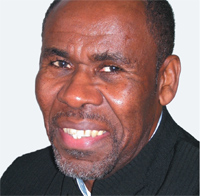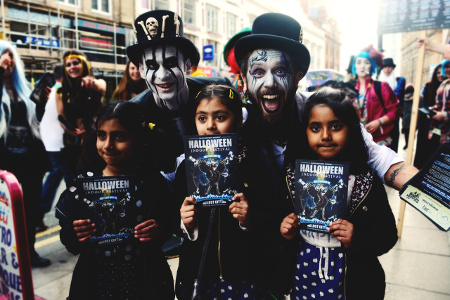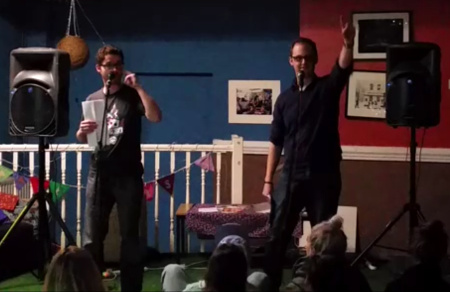‘A violent eruption of protest’: Reflections on the 1981 Moss Side ‘riots’ (part one)
Article published: Monday, August 15th 2011
Andy Bowman interviews Professor Gus John from the Moss Side Defence Committee about the Moss Side riots of July 1981
 1981 was the year in which British people of African descent protested against racism and police oppression as never before in modern history. The Black People’s Day of Action on 2 March 1981 brought around 25,000 people on to the streets of London to protest against the massacre of 13 young Africans in a fire at a birthday party in New Cross in South London suspected to be caused by racists. They also attempted to highlight the misconduct of the Metropolitan Police force in their subsequent investigation, the bias of the press, the inadequate response of the government to the tragedy and the generalised racial discrimination in British society. Added to the problem of racial discrimination, the Conservative government’s economic programme was making conditions worse in many poorer communities in inner city areas.
1981 was the year in which British people of African descent protested against racism and police oppression as never before in modern history. The Black People’s Day of Action on 2 March 1981 brought around 25,000 people on to the streets of London to protest against the massacre of 13 young Africans in a fire at a birthday party in New Cross in South London suspected to be caused by racists. They also attempted to highlight the misconduct of the Metropolitan Police force in their subsequent investigation, the bias of the press, the inadequate response of the government to the tragedy and the generalised racial discrimination in British society. Added to the problem of racial discrimination, the Conservative government’s economic programme was making conditions worse in many poorer communities in inner city areas.
Between April and August that year there was violent urban unrest in St Paul’s in Bristol, Brixton in South London, Toxteth in Liverpool, Moss Side in Manchester, Handsworth in Birmingham, and elsewhere in the country. Gus John lived through these years as a community activist and youth worker in Moss Side, having arrived in the UK from the West Indies in the 1960s. In the aftermath of the riots, he was a key figure in the Moss Side Defence Committee, which assisted with legal support to the youths charged by the police, challenged police violence and attempted to convey to the press and public a different interpretation of the events which had taken place. They would later undertake a detailed critique of the Hytner Report, established by the government to investigate the disturbances and their causes. Here Gus recalls his experiences of the times, in an interviewed carried out just a week before the recent outbreak of rioting across England’s urban centres.
Gus, what were conditions like when you arrived in Moss Side?
I arrived in Moss Side on the 1 January 1971, having worked on youth and race in Handsworth in Birmingham for the Runnymede Trust. There was a vibrancy about it, in that people had organised themselves around a campaign to do with housing. The local authority was doing compulsory purchases and knocking down houses which were actually rather sturdy – some of them had fallen into disrepair but structurally they were pretty fine. There were campaigns to save these houses because people were not enamoured with what they had seen in Hulme – these deck access crescent buildings, which were not just an eyesore, they became very dangerous after a while.
But the two things that stuck out for me were, first, a lot of young people coming out of school and being unemployed for a long time. It was taking the average school leaver about six months to find any employment, and some of them simply joined an earlier generation of fathers or siblings who had not worked. The second thing that was obvious was the way in which the police operated within the community – they tended to see black people as exotic … and generally formed the impression that the older people were safe and sound: they shared commonly held values, they were disciplinarians keeping the children under control, and it was really the youth which were at odds with the establishment, and the police as the most visible arm of the establishment.
It is true that at that time many parents didn’t want to see the police having cause to come near their home – it was seen as a massive stigma. It took a long time for parents to understand, based on their own experience, that your child didn’t have to do something wrong for the police to appear on your doorstep. It wasn’t always that young person’s fault that the police got involved in their lives.
In 1972 I had got some money from the British Council of Churches to set up a hostel for young black people, because they were sleeping on their friends’ floors or sleeping rough in Moss Side, the reason being that their parents had been decanted to places like Sale and Partington, as part of the whole so-called ‘regeneration’ business. And they continued to gravitate back to Moss Side, they would be here until after the last bus left, some of them would be in the night time dives – shebeens as we used to call them – and there was generally a sense of drift and disaffection among them. That made them even more in danger of getting involved with the police.
How similar were things in Moss Side to other areas of the UK you had worked in?
The four issues I just mentioned were present in all inner city areas I had worked in. I had just come from Handsworth, and one of the reasons for the Runnymede Trust commissioning the research I did there was that the Birmingham Evening Mail had run a series of stories called ‘The Angry Suburbs’, and one of them I remember was called ‘Must Harlem come to Birmingham?’ There were issues highlighted in those reports of unrest between black and white people which I have to say were not what I found in Birmingham.
Yes, there were tensions, with some white people feeling that black people were coming in numbers, taking homes etc, but what happened in Birmingham as in other parts of the country, was that the newcomers, black people from the Caribbean especially, were coming to find employment in areas where there was already an established working class, a neglected working class. So the quality of accommodation that local whites had was pretty poor anyway. As is typical of these situations, and not just in this country, the incoming black people were blamed for the squalor that had existed for generations.
So there were nuances, but generally you could identify issues which were common to most of those former industrial towns and cities. Many black children were being sent to schools for the educationally subnormal, not because they were in any way deficient, but because the schooling system refused to believe that those children were coming with a language of their own that was not Standard English.
That early period of 1968-73 was also the time when psychologists were propounding theories of scientific racism – suggesting that the intelligence levels of black people were lower than that of whites for genetic reasons. You had to battle against that gunge, especially as it was being taught in colleges that were training teachers – it really was horrendous.
What kind of police harassment did youngsters face in Moss Side?
I remember the first situation in which I personally intervened after arriving here, the police had stopped a young boy of about 13 cycling along Moss Lane West by the Hyde Brewery for riding his bicycle without lights. They were aggressive, and he was frightened. Rather than calming the situation, they started telling him to “stop being cheeky”, and before long there was a confrontation. As you went up and asked what was going on, they would tell you to “mind your own fucking business” or they would arrest you as well, for “obstructing the police in the course of their duty”.
We became aware of how vicious the police were to young people, so that when an incident like this happened, we would begin to gather, because the community wanted the police to know that we were watching what they were doing. The police became very on edge about that, very intolerant of the idea that anyone would witness what they were doing and question their conduct.
Here in Moss Side, as I had also witnessed in Oxford, Birmingham and London, it was not just happening to young people. Caribbean families, the men in particular, were proud of their cars. To own one was prestigious, and these men worked hard and bought their cars, and they were regularly being stopped by the police, for daring to own a vehicle like that: “Is it yours? Can you prove it is yours? What is your address? What is the proof of your address?” Constant petty harassment! There was a level of crime in these urban centres anyway, petty criminals as well as organised criminals – who were white. That criminality had not contaminated the black community in any measure when I came to Manchester.
Yes, some people got involved in crimes, burglaries etc. I used to teach black history at Wakefield Prison, and I was astounded by the zeal and zest with which prisoners there took to an understanding of black history and its relevance to them. They were interested in what was happening in the United States at the time, as they were about the 1962 Commonwealth Immigration Act, the 1968 Race Relations Act.
I told them about the work that I and others who were members of the Campaign Against Racial Discrimination did. How I would pair up with a white person and we would go looking for a room to rent or something. The black person would go in first and typically would have the door slammed in their face: “The room’s gone.” Your mate, the white person, would then go and was told, “It’s five shillings, when are you moving in?”
We did the same in relation to job applications. The black person would present a form with the best qualifications, the white person would present a form with lower qualifications, and the white person would automatically be given the job. We did this research up and down the country, and we were able to present the government with incontrovertible evidence of the extent of visceral racial discrimination, and that caused the Harold Wilson government to enact the 1968 Race Relations Act and establish the Race Relations Board which was the precursor of the Industrial Tribunal.
All those people in Wakefield Prison had what I called arrested growth: very bright people. Some could give you the most horrendous stories about their schooling, and why they dropped out of school. In some cases they had had physical altercations with teachers, and were either expelled from school or never went back.
The fact is, there was not a high degree of engagement in delinquency or criminality among the African-Caribbean population … Now relative to our numbers in the population overall, the highest proportion of people in the prisons and young offender institutions are black people.
Ever since the beginning of the 1960s there has been systemic structural and structured exclusion of black people within the society, and that has got certain consequences. It becomes easy to believe that that is because black people don’t have brains, which of course is complete nonsense. All of that is an important back-story to what people in Manchester were experiencing and grappling with in the 1970s and 1980s.
How active were organised racist groups in Manchester during the 1980s? Groups like the National Front?
Very active. In the year of the disturbances in Moss Side there were running battles between us and the NF. They had the temerity to come and hand out leaflets in Moss Side and Hulme, trying to inflame the passions of white people and encourage them to blame black people for whatever social deprivation they were suffering. What was pleasing about that was that the white community determined that they wanted nothing to do with the NF, and joined political activists such as myself, deciding that they as a white community would not allow the NF to get one inch of space within the white community, and physically booted them out.
So you had the harassment of the police, and then you had the planned collective attacks by white racists – people would be physically attacked, have excrement and firebombs put through their doors, or there would be NF signs put up around the place. That didn’t come from nowhere – the neo-fascists became emboldened by the lead politicians gave…
Such as Enoch Powell?
Yes, such as Enoch Powell, but he could be seen as the extreme end of the spectrum. His problem was that he was open and honest about those matters. It was the people who were passing laws in Parliament, one more draconian piece of immigration legislation than the one before, who were constantly conflating immigration and race relations and holding up the spectre of an alien black force destabilising an assumed settled and cohesive society.
It was like a mantra: “You can’t have good race relations unless you control immigration”. In other words, if you don’t control immigration, the white population will get fed up that you’re expecting them to be too tolerant of these blacks. Or the black population would start creating mayhem. As a consequence, every year at a certain point, even before the Office for National Statistics published their reports; you would find some newspaper, principally the tabloids such as the Sun and Daily Mail, publishing figures about the number of live births to immigrants. It was all scaremongering, a moral panic about black people, and an insistence on keeping Britain white. And people talked openly about the need to keep Britain white.
You have to situate the 1981 uprisings in that broader context, and if you don’t, you fail to understand the structural relationship between the way black people experience living in the society, and the way they choose to resist.
And the resistance took many forms, it took political forms, it took cultural forms, through music, art, publishing or through soundsystems and travelling discos – people find ways of surviving, and not allowing their essential humanity to be debased, and expressing and affirming their creativity. Cultures of oppression inexorably spawn cultures of resistance.
Given all this background, how surprised were you when the riots broke out? A lot of the press coverage at the time, and now in reflection, talks about the riots being a ‘spontaneous’ event.
It wasn’t a surprise to me nor many other people in Moss Side. It could have happened any time before that July. It could have happened in March that year, when a cache of illegal weapons were found stashed in Moss Side police station. Those weapons were found to be knives, hatchets, coshes, clubs, and a considerable quantity of cannabis was also found.
We were alarmed because we knew the police planted cannabis on unsuspecting citizens, and would then throw the book at them for drug possession. They also used to give cannabis to prostitutes to sell, and if they didn’t comply they would be dragged in for prostituting themselves. Typically, when people got arrested and taken to Moss Side Police Station or Platt Lane Police Station, they were likely to get a good hiding from the police, to reveal the names of others or confess to some crime, or just for being ‘lippy’ and standing up for themselves, whether they did or did not commit a crime.
So it was alarming that this cache was found in the police station. What were the police going to do with them? No sooner did the reports come out than everything disappeared. That was on March 12-13 1981. Ten days earlier, six coach loads of people had left here for London, to go to the biggest march black people here have ever organised, the New Cross Massacre Black People’s Day of Action, on 2 March 1981, following the murder of those 13 young people in that Deptford fire.
That massacre did not take place in Moss Side, but it could well have. That became a metaphor for the experiences that we were having at the hands of the racists and fascists across the country, and the way the police dealt with those things. So the events in July in Moss Side could have happened at any point that year.
Part two of the interview can be found here
More: Features, Interviews, Policing
Comments
-
[…] Part 1 of the interview can be found here […]
Pingback by ‘A violent eruption of protest’: Reflections on the 1981 Moss Side ‘riots’ (part two) — MULE on August 25, 2011 at 8:59 pm -
[…] Violent eruption of protest : part one […]
Pingback by Reflections on the 1981 Moss Side ‘Riots’ : Gus John - In Defence of Youth Work on August 26, 2011 at 10:17 am
The comments are closed.



